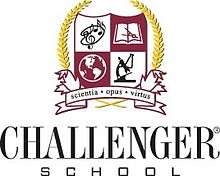Challenger School

The Challenger School network contains, as of 2007, twenty-three educational institutions in multiple U.S. states. Generally associated with the western United States, these private schools are known for their high academic standards.[1]
Founding and early history
Challenger School began as a project by American educator Barbara Baker in the 1960s. Baker taught first grade in the regular U.S. public school system and experienced frustration with changes in teaching methods. She realized that her students were taught how to read in kindergarten by memorizing each individual word rather than using phonics to sound out the words; she felt this method was inefficient and didn't prepare students for future education.[2]
Baker decided to leave her teaching job and start her own preschool, teaching phonics as well as other traits to young children to help them in grade school. Parents in the community gained interest in Baker's preschool work, and what originally started as a very small institution grew into a huge educational system. Baker remained the CEO of the Challenger School network for decades. She died, at age 81, in 2012.[2]
Later history
The schools have greatly changed over the years.
In the early to mid 2000s, the educational network expanded significantly.[1]
In 2007, researchers John Fleming and Elizabeth Kleinhenz wrote in their book Towards a Moving School, published by the Australian Council for Educational Research, that the Challenger school network had succeeded in applying tough standards and setting effective policies in terms of curriculum planning and execution. The schools' belief that all students could achieve at high levels received praise as well. It was noted, however, that the schools required high fees.[1]
Curriculum
The schools have 11 main courses: literature, spelling/vocabulary, composition/grammar, logic (up to 7th grade), mathematics, history (3rd-8th grade, geography (pre-K to 2nd grade), economics (8th grade only), science, computers (1st to 8th grade), and SDT (speech, debate, theater; debate and theater start in middle school). The schools have 3 minor courses: music, art, and physical education.[3] At the beginning of the school year, students 5th grade and above are required to do the Daughters Of The American Revolution Essay Contest. Students from grades Kindergarten through 2nd Grade will do a Class Science Project together, while 3rd Grade students and above will create their own Science Project. 3rd and 4th Grade allows you to do a demonstration or experiment, while 5th through 7th only allows you to do an experiment. 8th graders can also create their own inventions. Challenger School also has a Spelling Bee, math contest, Geography Bee, Speech Festival, creative writing contest, and computer programming contest. During the school year, students have to take several CAT (Challenger Achievement Test) tests and an IOWA test in March. In addition, several students participate in activities such as Math Counts, AMC 8, Letters About Literature, and Science Olympiad through their school.
Values
Challenger encourages its students to work hard. Its mission "is to prepare students to become self-reliant and productive individuals; to teach them to think, speak, and write with clarity, precision, and independence; to lead them to recognize their individuality and unalienable rights; and to inspire them to embrace challenge and gain joy and self-worth through achievement."
There are 7 values emphasized at Challenger: rationality, productivity, justice, self-reliance, honesty, integrity, and self-worth.
Reviews and reputation
The schools have been receiving mixed review from the public. Some parents of students in the schools say it's more than amazing, while others say harsh words about the schools. The good reviews are made up of: Excellent curriculum, amazing academics, great teachers. The bad reviews are made up of: Lack of social skills, Not enough Physical Education or Art and Music, Horrible Management. Challenger School has received great reviews from the school analysts, but most of the bad reviews were from the parents themselves. The employees of the schools also say mixed outlooks, considering from pay all the way to staff management.[4][5][6]
See also
References
- 1 2 3 Fleming, John; Kleinhenz, Elizabeth (2007). Towards a Moving School: Developing a Professional Learning and Performance Culture. Australian Council for Educational Research. pp. 91–92. ISBN 9780864317025.
- 1 2 "History of Challenger". Challengerschool.com. Retrieved October 1, 2015. External link in
|publisher=(help) - ↑ "Challenger School". Challengerschool.com. Retrieved September 14, 2015.
- ↑ "Challenger - Shawnee - San Jose, California - CA - School overview". Greatschools.org. Retrieved September 14, 2015.
- ↑ "Challenger School - Sunnyvale - 11 Photos - Elementary Schools - Sunnyvale, CA - Reviews - Yelp". Yelp.com. Retrieved September 14, 2015.
- ↑ "Challenger School Reviews". Glassdoor.com. Retrieved September 14, 2015.